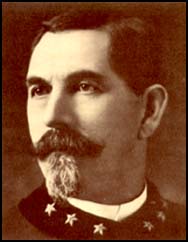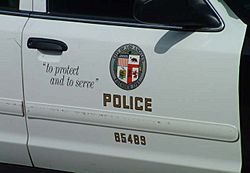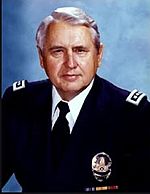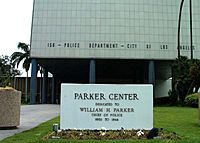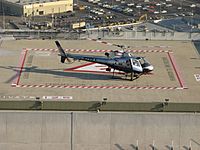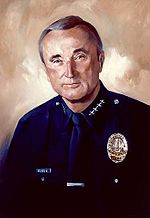History of the Los Angeles Police Department facts for kids
The Los Angeles Police Department (LAPD) started in 1869. It has grown to become one of the biggest police forces in the United States. The LAPD has been part of many important moments in history.
Contents
Early Days of the LAPD
During the California Gold Rush, Los Angeles was a wild place. There was a lot of crime and not many police officers. People often carried weapons, and there wasn't a strong system to keep order.
The first police group in Los Angeles was formed in 1853. It was called the Los Angeles Rangers. These were volunteers who helped the local sheriff. Later, other volunteer groups like the Los Angeles Guards also helped.
The first paid police officers were hired in 1869. There were six officers working under City Marshal William C. Warren. After some changes in leadership, John M. Glass became chief in 1889. He worked to make the police force more professional. By 1900, there were 70 officers.
In 1910, the LAPD made history. They hired Alice Stebbins Wells, the first female police officer in the United States with full police powers. In 1916, Georgia Ann Robinson became the first African-American female police officer in the country.
LAPD During World Wars
During World War I, the LAPD helped with national security. A special "Home Guard" was formed from many officers. After the war, the department faced challenges with honesty.
Some police chiefs worked hard to improve the force. August Vollmer started new ideas for better policing. James E. Davis fired officers who behaved badly. He also started better training for using firearms. He also used a "dragnet system" to catch criminals.
In the late 1930s, Mayor Fletcher Bowron worked to clean up the city government. He removed many city officials and over 45 LAPD officers. He also appointed the first African American and the first woman to the Police Commission.
During World War II, many officers joined the armed forces. This made the LAPD smaller. New officers received less training than usual. The police had a tough time controlling the 1943 Zoot Suit Riots.
One famous case during this time was the 1947 murder of Elizabeth Short, known as the Black Dahlia. After this, Chief Clemence B. Horrall left his position. He had approved a radio show about the LAPD called Dragnet. He also helped start the LAPD's "Gangster Squad" in 1946. This group worked to stop organized crime in the city.
LAPD from 1950 to 1965
After Horrall, William H. Parker became chief in 1950. He believed police should be very professional and independent. Parker was chief for a long time, until his death in 1966.
The LAPD's famous motto, "To Protect and to Serve," was first used in 1955. It became the official motto for the whole department in 1963.
During this time, the LAPD was seen as a model for police professionalism. TV shows like Dragnet and Adam-12 showed this image. However, a big challenge came in 1965 with the Watts riots. These riots happened after accusations of unfair treatment by police towards minority communities. For six days, there was looting and fires. The California Army National Guard had to help the LAPD restore order. Over 34 people died, and many buildings were damaged.
Edward M. Davis as Chief
After Parker, Edward M. Davis became chief in 1969. Chief Davis started new programs to connect with communities. He also created special units to deal with street gangs. One important creation was the SWAT unit in 1972. SWAT stands for Special Weapons and Tactics. These teams are trained for dangerous situations.
Deputy Chief Louis Sporrer helped set up the gang control units. In 1972, street gangs like the Crips and Bloods were growing. A "Gang Intelligence Unit" was created. A uniformed team called TRASH (Total Resources Against Street Hoodlums) was also formed. Later, the name was changed to CRASH (Community Resources Against Street Hoodlums) because some people thought TRASH was demeaning. These CRASH units still work today.
Chief Davis also pushed for "basic car plan" or "team policing." This meant officers were assigned to specific areas for a long time. This helped officers get to know their communities better. It also helped build trust and respect between the police and the people they served.
LAPD from 1978 to 2002
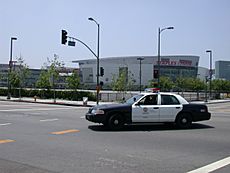
Daryl F. Gates became chief in 1978. During his time, the department's budget was cut. This meant fewer police officers, even as crime increased. To fight gang violence, Gates started Operation Hammer in 1987. This led to many arrests, especially of young black and Hispanic people.
Gates retired in 1992, after the Rodney King events and the 1992 Los Angeles riots. He was replaced by Willie L. Williams, the first African-American chief. In 1997, Bernard C. Parks became chief. During his time, the LAPD faced the Rampart Division/CRASH scandal, which involved corruption.
In 1997, the LAPD and its SWAT team faced a major challenge. This was the North Hollywood shootout. Two bank robbers, wearing body armor and armed with powerful rifles, shot twelve officers and two civilians. SWAT units eventually stopped the suspects after a long gun battle.

In 1997, the LAPD took over the MTA Transit Police. This was meant to combine police forces. However, only some of the transit officers joined the LAPD. Later, the MTA gave the entire transit policing contract to the Los Angeles County Sheriff's Department.
In 2002, Mayor Hahn decided not to keep Chief Parks for another term. This was due to a loss of officers and a high crime rate. Voters also approved Proposition Q in 2002. This bond provided $600 million to improve police and fire buildings. This included replacing old police stations and building new ones.
William J. Bratton as Chief
Chief William J. Bratton became the head of the LAPD after leading other police departments. He had several goals. He wanted to reduce crime and create a strong counter-terrorism unit. He also wanted to improve community policing.
In 2005, the LAPD started showing short action movies online and in theaters. These movies featured real LAPD officers to encourage people to join the force. Bratton retired in 2009.
In 2005, Los Angeles voters rejected a plan to combine the LAPD with the Los Angeles Airport Police. People argued that Airport Police had special training for airport security.
In 2006, the LAPD started building new police stations. This included replacing old ones like Hollenbeck and Harbor. They also began building a new Police Administration Building to replace Parker Center. New community police stations were also planned and opened, like the 20th (Olympic Area) and 21st (Topanga Area) Police Stations.
In 2006, Mayor Antonio Villaraigosa began a plan to hire about 1,000 more LAPD officers over five years. This was funded by small increases in trash collection fees.
In 2008, a SWAT officer named Randal Simmons was killed in the line of duty. He was the first SWAT officer to die while working since the unit was created.
LAPD from 2009 to Present
On November 17, 2009, Charles L. Beck became the new Chief of the Los Angeles Police Department. He had been with the department for 32 years. He was known for helping to improve the Rampart Division after the Rampart Scandal.
Central Receiving Hospital
The Los Angeles Police Department used to run its own emergency hospital. It was called the Central Receiving Hospital. It operated for 102 years, from 1868 to 1970.
It started as a place for sick patients. In the 1880s, it moved into the Central Police Station. It became a first aid station for the police. Over the years, it moved to different police buildings. It was the first public hospital in Los Angeles to provide emergency care.
|


